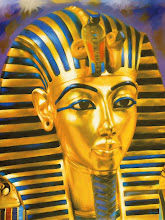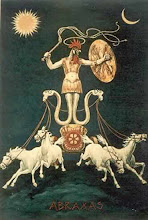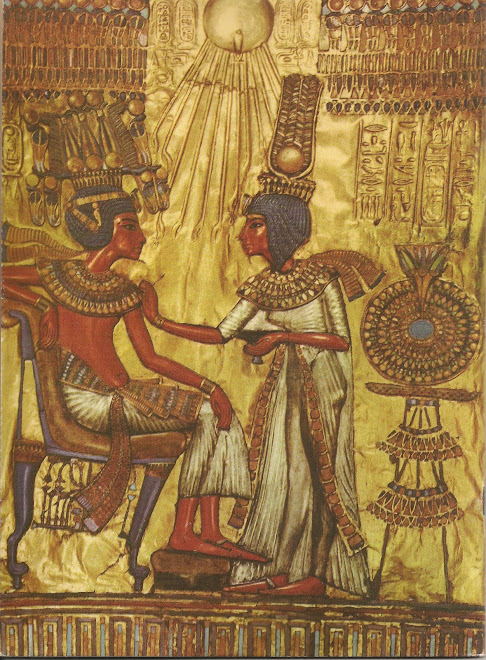Aleister Crowley wrote The Gnostic Mass — technically called Liber XV or "Book 15" — in 1913 while travelling in Moscow, Russia. In many ways it is similar in structure to the Mass of the Eastern Orthodox Church. However, the comparison ends there, as Liber XV is a celebration of the principles of Thelema.[citation needed] It is the central rite of Ordo Templi Orientis and its ecclesiastical arm, Ecclesia Gnostica Catholica.
The ceremony calls for five officers: a Priest, a Priestess, a Deacon, and two acolytes, called Children (though current practice is that the part is usually performed by adults).[citation needed] The end of the ritual culminates in the consummation of the eucharist, consisting of a goblet of wine and a Cake of Light, after which the congregant proclaims “There is no part of me that is not of the gods!”
Crowley explains why he wrote the Gnostic Mass in his Confessions:
While dealing with this subject I may as well outline its scope completely. Human nature demands (in the case of most people) the satisfaction of the religious instinct, and, to very many, this may best be done by ceremonial means. I wished therefore to construct a ritual through which people might enter into ecstasy as they have always done under the influence of appropriate ritual. In recent years, there has been an increasing failure to attain this object, because the established cults shock their intellectual convictions and outrage their common sense. Thus their minds criticize their enthusiasm; they are unable to consummate the union of their individual souls with the universal soul as a bridegroom would be to consummate his marriage if his love were constantly reminded that its assumptions were intellectually absurd.
I resolved that my Ritual should celebrate the sublimity of the operation of universal forces without introducing disputable metaphysical theories. I would neither make nor imply any statement about nature which would not be endorsed by the most materialistic man of science. On the surface this may sound difficult; but in practice I found it perfectly simple to combine the most rigidly rational conceptions of phenomena with the most exalted and enthusiastic celebration of their sublimity.[1]
Contents
1 Publications of the Mass
2 The Temple
3 Structure
3.1 The Ceremony of the Introit
3.2 The Ceremony of the Rending of the Veil
3.3 The Collects
3.4 The Consecration of the Elements
3.5 The Anthem
3.6 The Mystic Marriage and Consummation of the Elements
4 The narrative of the Gnostic Mass [4]
5 See also
6 References
7 External links
Publications of the Mass
Crowley published the text of the Gnostic Mass three times: in 1918 in a publication called The International, in 1919 in The Equinox (III:1), and in 1929 in Magick in Theory and Practice. It was privately performed while Crowley was at the Abbey of Thelema in Sicily, Italy,[2] and its first public performance was March 19, 1933 by Wilfred T. Smith and Regina Kahl in Hollywood, California at the first Agape Lodge.[3]
The Temple
There are four main pieces of furniture in a Gnostic Mass temple:
The High Altar: the dimensions are 7 feet (2.1 m) long by 3 feet (0.91 m) wide by 44 inches (1,100 mm) high. It is covered with a crimson cloth. It is situated in the East, or in the direction of Boleskine House--Crowley's former estate—on the shores of Loch Ness in Scotland ("Temple East"). The two-tiered super-altar sits on top of the High Altar. It all holds 22 candles, the Stele of Revealing, the Book of the Law, the Cup, and two bunches of roses. There is room for the Paten, and the Priestess to sit.
The High Altar is contained within a great Veil, and sits on a dais with three steps. On either side of the High Altar are two pillars, countercharged in black and white.
The Altar of Incense: to the West of the Dais is a black altar made of superimposed cubes.
The Font: this is a small circular item which is able to contain or hold water.
The Tomb: this is generally a small, enclosing space with an entrance that is covered by a veil. It should be big enough to hold the Priest, Deacon and the two Children.
Structure
There are six component ceremonies within the Gnostic Mass:
The Ceremony of the Introit
The congregation enters the temple, the Deacon presents the Law of Thelema, and the Gnostic Creed is recited. The Priestess and the Children enter from a side room. The Priestess raises the Priest from his Tomb, then purifies, consecrates, robes and crowns him.
The Ceremony of the Rending of the Veil
The Priestess is enthroned at the High Altar and the veil is closed. The Priest circumambulates the temple and he ascends to the veil. The officers give their orations, including the Calendar by the Deacon. The Priest then opens the veil and kneels at the High Altar.
The Collects
Eleven prayers addressed to the Sun, Moon, Lord, Lady, Gnostic Saints, Earth, Principles, Birth, Marriage, Death, and The End.
The Consecration of the Elements
The preparation of the Eucharist.
The Anthem
Of the Anthem, Crowley writes in Confessions:
During this period [i.e. around 1913] the full interpretation of the central mystery of freemasonry became clear in consciousness, and I expressed it in dramatic form in The Ship. The lyrical climax is in some respects my supreme achievement in invocation; in fact, the chorus beginning: “Thou who art I beyond all I am...” seemed to me worthy to be introduced as the anthem into the Ritual of the Gnostic Catholic Church.
The Mystic Marriage and Consummation of the Elements
The Eucharist is perfected and consumed. The Priest gives the final benediction. The Priest, Deacon, and Children exit. The People exit.
The narrative of the Gnostic Mass [4]
The People enter into the ritual space, where the Deacon stands at the Altar of Incense (symbolic of Tiphareth on the Tree of Life). She takes the Book of the Law and places it on the super-altar within the great Veil, and proclaims the Law of Thelema in the name of IAO. Returning, she leads the People in the Gnostic Creed, which announces a belief (or value) in the Lord, the Sun, Chaos, Air, Babalon, Baphomet, the Gnostic Catholic Church, the communion of Saints, the Miracle of the Mass (i.e. the Eucharist), as well as confessions of their birth as incarnate beings and the eternal cycle of their individual lives.
The Virgin then enters with the two Children, and greets the People. She moves in a serpentine manner around the Altar of Incense and the Font (symbolizing the unwinding of the Kundalini Serpent which is twined around the base of the spine) before stopping at the Tomb. She tears down the veil with her Sword, and raises the Priest to life by the power of Iron, the Sun, and the Lord. He is lustrated and consecrated with the four elements (water and earth, fire and air), and then invested with his scarlet Robe and crowned with the golden Uraeus serpent of wisdom. Finally, she gently strokes his Lance eleven times, invoking the Lord.
The Priest lifts up the Virgin and takes her to the High Altar, seating her upon the summit of the Earth. After he purifies and consecrates her, he closes the Veil and circumambulates the temple three times, followed by the remaining officers. They take their place before the Altar of Incense, kneeling in adoration (along with all the People), while the Priest takes the first step upon the Dais before the Veil. In this symbolic crossing of the Abyss, the Priest begins with his first oration, invoking Nuit, the goddess of the infinite night sky. The Priestess calls to him as Nuit, enticing the Priest to ascend to her. He then takes the second step, and identifies as Hadit, the infinitely condensed center of all things — the Fire of every star and the Life in every person. The Deacon has the congregation rise and he delivers the Calendar. The Priest takes his third and final step, invoking Ra-Hoor-Khuit, the Crowned and Conquering Child of the New Aeon. With his Lance, he parts the Veil, revealing the now-naked Priestess who sits upon the High Altar. He greets her with the masculine powers of Pan and she returns it with eleven kisses on the Lance. He kneels in adoration.
The Deacon then recites the eleven Collects, which include the Sun, Moon, Lord, Lady, Saints, Earth, Principles, Birth, Marriage, Death, and the End.
The Elements are then consecrated by the Virtue of the Lance, transforming the bread into the Body of God and the wine into the Blood of God. Of these, the Priest makes a symbolic offering to On, being our Lord the Sun.
The Priest and all the People then recite the Anthem, which was taken from Crowley’s allegorical play "The Ship", and represents the legend of the Third Degree of Masonry.
The Priest blesses the Elements in the name of the Lord, and also states the essential function of the entire operation, which is to bestow health, wealth, strength, joy, peace, and the perpetual happiness that is the successful fulfillment of will. He breaks off a piece of one of the hosts, and, placing it on the tip of the Lance, both he and the Priestess depress it into the Cup, crying “Hriliu” (which Crowley translated as “the shrill scream of orgasm”).
The Priest entreats Baphomet — "O Lion and O Serpent" — to be “mighty among us.” He then declares the Law of Thelema to the People - "Do what thou wilt shall be the whole of the Law" - who return with “Love is the law, love under will.” He finally partakes of the Eucharist with the words, “In my mouth be the essence of the life of the Sun” (with the Host) and “In my mouth be the essence of the joy of the earth” (with the Wine). He turns to the People and declares, “There is no part of me that is not of the Gods.”
The People then follow in Communication, one at a time, much as the Priest did, by partaking of a whole goblet of wine and a Cake of Light. They make the same proclamation of godhood as did the Priest. Afterwards, the Priest encloses the Priestess within the Veil, and delivers the final benediction:
+ The LORD bless you.
+ The LORD enlighten your minds and comfort your hearts and sustain your bodies.
+ The LORD bring you to the accomplishment of your true Wills, the Great Work, the Summum Bonum, True Wisdom and Perfect Happiness.
The Priest, Deacon, and Children then retire to the Tomb and return the torn veil. The People exit.
See also
Works of Aleister Crowley
http://en.wikipedia.org/wiki/Works_of_Aleister_Crowley
Libri of Aleister Crowley
http://en.wikipedia.org/wiki/Libri_of_Aleister_Crowley
Sex magick
http://en.wikipedia.org/wiki/Sex_magic
References
1.^ Crowley, Aleister (1989). The Confessions of Aleister Crowley: An autohagiography. London: Arkana. ISBN 978-0-14-019189-9.
2.^ Crowley, Aleister (1933-07-02). "Black Magic is Not a Myth". The London Sunday Dispatch (London). http://hermetic.com/crowley/articles/black-magic-is-not-a-myth.html. Retrieved 2011-12-18.
3.^ Apiryon, T. "The Invisible Basilica: Introduction to the Gnostic Mass". http://www.hermetic.com/sabazius/intromass.htm. Retrieved 2009-05-24.
4.^ The text of The Gnostic Mass
External links
The Gnostic Mass, full text with hyperlinked annotations
http://hermetic.com/sabazius/gnostic_mass.htm
A First Look at the Gnostic Mass, by Dionysos Thriambos
http://www.scarletwoman.org/docs/docs_firstlook.html
Original Essays and Propaganda of Dionysos Thriambos regarding the Gnostic Mass & the E.G.C.
http://hermetic.com/dionysos/essays.htm
Apiryon, T. "The Invisible Basilica: Introduction to the Gnostic Mass". http://www.hermetic.com/sabazius/intromass.htm. Retrieved 2009-05-24.
http://hermetic.com/sabazius/intromass.htm
The Gnostic Mass: Annotations and Commentary by Helena and Tau Apiryon
http://hermetic.com/sabazius/gmnotes.htm
The Gnostic Mass: An Appreciation by A.T. Dennis
http://hermetic.com/egc/appreciation.html
GnosticMass.org
http://www.gnosticmass.org/
Source: http://en.wikipedia.org/wiki/Liber_XV,_The_Gnostic_Mass
More Info: http://thelemapedia.org/index.php/The_Gnostic_Mass
YouTube:
Mass of the Gnostic Catholic Church as written by Crowley, performed by Fr. VonHohenheim (priest) Sr Iris (Priestess) Fr. Q'Tasshi (Deacon), Fr. Freeshadow (Child), and Fr. Clintax (Child) at William Blake Lodge in Baltimore Maryland December 2008. To find out where you can see a mass near you visit www.oto-usa.org for more info on William Blake Lodge go to www.williamblakeoto.org and for more work by VH go to www.geocities.com/ararita418 :



.jpg)
.jpg)
















+001.jpg)




+001.jpg)



+001.jpg)





+001.jpg)

+001.jpg)

+001.jpg)
+001.jpg)
+001.jpg)
.jpg)



Sem comentários:
Enviar um comentário
Nota: só um membro deste blogue pode publicar um comentário.